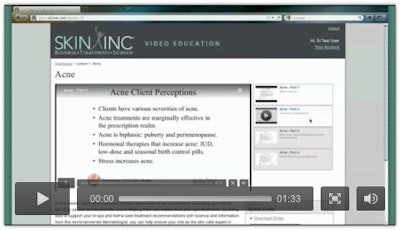
Skin Inc. is dedicated to providing high quality education for the professional skin care industry, and Skin Inc. Video Education is here to meet that need! The first course, Physiology of the Skin, is based on the Physiology of the Skin book series by Peter T. Pugliese, MD, and Zoe Draelos, MD. Learn the science behind the function and structure of the skin as it relates to acne, the sun, aging skin and medical spa.
Don't know what to expect? Read the lesson excerpt below from the first lesson, "Acne", and view the Take a Tour video!
 Click to play the video
Click to play the video
Excerpt: Zoe Draelos transcript from the first few minutes of the Acne lesson
"Acne afflicts many people. It knows no age limits. It affects both men and women. So, over the next hour, let’s understand a little bit about acne, how it can be treated and how it can be prevented.
Let’s begin our discussion by evaluating what exactly is acne. One of the most important things for the presence of acne is oil. Without oil or sebum, there can be no acne, and that’s why young people who do not have enough production do not see acne until puberty, when oil production turns on. That oil is known as sebum, and abundant sebum allows acne to be present. Acne is actually a self-curing disease. It also disappears when the oil disappears with advancing age.
Believe it or not, acne affects approximately 40-50 million Americans. The technical name for acne is Acne vulgaris. Vulgaris is a Latin word that means common. Upward of 80% of people between the ages of 11 and 30 years of age develop acne. It is one of the most common skin diagnoses, and it can persist for years, causing both scarring and pigmentation.
Interestingly enough, what actually causes acne is the presence of a bacteria in the skin known as P. acnes, or Proprianum bacterium acnes. Acne is really an infection. The bacteria is present on everybody’s face; however some people tend to have a more dramatic reaction to the presence of the bacteria than others.
What happens is the Proprianum bacterium acnes eat the oil in the skin and release a highly irritating substance known as a free fatty acid. That free fatty acid attracts neutrophils, a specific type of white blood cell that enters the skin in the area of the hair and the oil producing gland known as the sebaceous gland. This neutrophil produces reactive oxygen species, basically releasing hydrogen peroxide into the skin, damaging the skin, resulting in scarring and also causing tissue injury. This tissue injury is accompanied by painful bumps and lumps that are present both on top of and in the skin. If you really think about it, acne is really an infectious disease."
Disclaimer:
The above paid-for content was produced by and posted on behalf of the Sponsor. Content provided is generated solely by the Sponsor or its affiliates, and it is the Sponsor’s responsibility for the accuracy, completeness and validity of all information included. Skin Inc. takes steps to ensure that you will not confuse sponsored content with content produced by Skin Inc. and governed by its editorial policy.










